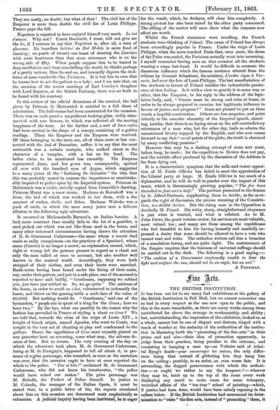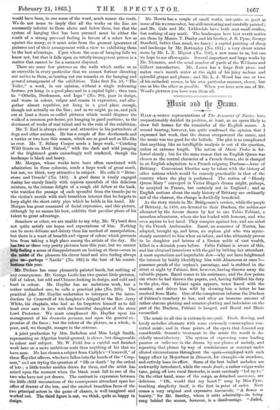Arts.
THE BRITISH INSTITUTION.
Ir has been our lot to see many bad exhibitions at the gallery of the British Institution in Pall Mall, but we cannot remember one so bad in every respect as the one now open to the public, and this is the more remarkable, as there are many works among those contributed far above the average in workmanship and ability ; but, notwithstanding, the impression of the exhibition, looked on as a whole, cannot but be one of disgust and distress, tinged with a touch of wonder at the audacity of the authorities of the institu- tion in blazoning forth the " promoting of the fine arts" as their prime end and aim—their idea of promotion apparently, to judge from their practice, being peculiar in the extreme, and consisting in hanging a man up—as Voltaire said of Admi- ral Byng's death—pour encourager les autres, the only differ- ence being that instead of gibbeting him they hang him on the ceiling ; possibly, to an artist, an even worse fate. It is astounding, the dogged perseverance with which the authori- ties — or ought we rather to say the hangmen 7— whoever they may be, hoist up to the top of the room every work displaying any merit to make room for some trumpery, wretched affairs of the " tea-tray " school of painting—which, if justice had been done, would have been calmly reposing in the cellars below. If the British Institution had announced its deter- mination to "raise " the fine arts, instead of " promoting " them, it would have been, in one sense of the word, much nearer the truth. We do not mean to imply that all the works on the line are necessarily inferior to those above and below them, but that the system of hanging that has been pursued must be either the result of a strong personal feeling in favour of a select few as against the many, or it must arise from the grossest ignorance of pictures and of their arrangement with a view to exhibiting them to the best advantage. Upon whom the onus of hanging falls we know not, but that it falls upon an utterly incompetent person is a matter that cannot be for a moment disputed.
There are some few pictures on the walls which strike us as so execrable in every particular that we cannot forbear directing our notice to them, as bearing out our remarks on the hanging and general arrangement of the exhibition. Take first No. 53, "The Toilet.," a work, in our opinion, without a single redeeming feature, yet hung in a good place and in a capital light ; then turn to "Othello, Desdemona, and Iago " (No. 90), poor in design, and worse in colour, vulgar and coarse in expression, and alto- gether almost repulsive, yet hung in a good place enough, though not actually on the line ; and so we might go on, and pick out at least a dozen so-called pictures which would disgrace the walls of a common pot-house, yet hanging in good positions, to the detriment of works of real talent and to the ruin of the exhibition.
Mr. T. Earl is always clever and attractive in his portraiture of dogs and other animals. He has a couple of fine deerhounds and a terrier or two here this season, which are as good and as life-like as ever. Mr. T. Sidney Cooper sends a large work, " Catching Wild Goats on Mod Siabod," with the dash and wild jumping of the frightened goats exceedingly well rendered, though the landscape is black and heavy.
Mr. Morgan, whose works have been often mentioned with admiration in these columns, sends a large work of great merit, but not, we think, very attractive in subject. He calls it " Brim- stone and Treacle" (No. 143). A good dame is busily engaged dosing her unruly family with copious spoonfuls of this delicious mixture, to the intense delight of a rough old fellow at the back, who watches the passage of each spoonful from the treacle-jar to the victim's mouth with such breathless interest that he forgets to keep alight the short cutty pipe which he holds in his hand. Mr Morgan has great command of facial expression, and this picture, although by no means his best, exhibits that peculiar phase of his talent to great advantage.
• Somehow or other, we are unable to say why, Mr. Wyburd does not quite satisfy our hopes and expectations of him. Nothing can be more delicate and dainty than his method of manipulation, but there is a want of breadth and vigour of colour which prevents him from taking a high place among the artists of the day. He has two or three very pretty pictures here this year, but we cannot help feeling a sense of disappointment on looking at them—even in the midst of the pleasure his clever hand and nice feeling always give use—perhaps " Xarifa" (No. 182) is the best of his contri- butions this year.
Mr. Dicksee has some pleasantly painted heads, but nothing of any consequence. Mr. George Leslie has two quaint little pictures, full of talent, but odd and Chinese-looking in design, and cold and hard in colour. Mr. Hayllar has an ambitious work, but a rather unfinished one, he calls a practical joke (No. 283). The practical joke Mr. Hayllar undertakes to interpret is the intro- duction by Cromwell of his daughter's Abigail to the Rev. Jerry White, his chaplain, who had so far forgotten himself as to fall head over ears in love with the beautiful daughter of the stern Lord Protector. We must compliment Mr. Hayllar upon his management of his dramatis persona, and upon the general ex- pression of the faces ; but the colour of the picture, as a whole, is poor, and, we thought, meagre in the extreme.
A joint production by Mrs. Bodichon and Miss Leigh Smith, representing an Algerian burial-ground, is clever, but disagreeable, in colour and subject. Mr. W. Field has a careful and finished work here on a more ambitious scale than anything of his that we have seen. He has chosen a subject from Carlyle's" Cromwell," of three Royalist officers, who have fallen into the hands of the " Crop- ears," and are trying the question of "life or death " by the ordeal of lots ; a little tender maiden draws for them, and the artist has seized upon the moment when the blank must fall to one of the two who have not yet drawn. The contrast in expression between the little child unconscious of the consequence attendant upon her office of drawer of the lots, and the excited breathless faces of the two principal actors in the game of chance, is well imagined and worked out. The third figure is not, we think, quite so happy in design. Mr. Morris has a couple of small works, not quite so good as some of his we remember, but still interesting and carefully painted ; and Mr. Gale and Mr. Lidderdale have both sent small studies, but nothing of any mark. The landscapes here best worth notice are those by Messrs. T. Denby and his brother, J. B. Pyne, George Stanfield, better than usual, we fancy ; a capital painting of sheep and landscape by Mr. Bottomley (No. 193) ; a very clever winter scene by Mr. L. H. Mignot (No. 106), a new name to us, but one we hope to see often again. Several important and large works by Mr. Niemann, and the usual number of yards of the Williams and Gilbert manufacture. Mr. Lance has a large fruit piece, and makes one's mouth water at the sight of his juicy melons and splendid grapes and plums ; and Mr. L. J. Wood has one or two of his cathedral scenes, in his own particular manner, clever, but one as like the other as possible. When you have seen one of Mr. Wood's pictures you have seen them all.































 Previous page
Previous page